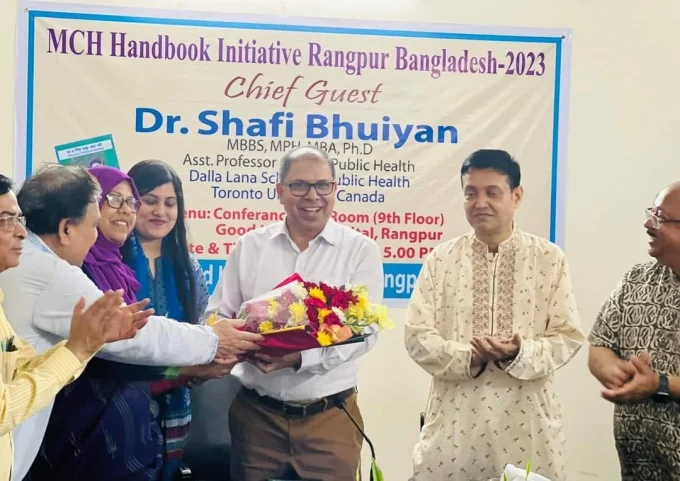প্রফেসর- ড. মোহা: ইয়ামিন হোসেন
ফিশারীজ বিভাগ, রাজশাহী বিশ্ববিদ্যালয়।
“Conservation of National Fish Tenualosa ilisha in the Padma River, NW Bangladesh” বিষয়টির ওপর স্মার্টলি প্রেজেন্টেশন দেওয়ার জন্য কিছু গুরুত্বপূর্ণ ধাপ রয়েছে।
এই প্রেজেন্টেশনের জন্য আপনাকে কিভাবে প্রস্তুতি নিতে হবে, প্রেজেন্টেশন তৈরি করতে হবে, এবং উপস্থাপনাটি আকর্ষণীয় ও প্রভাবশালী করতে হবে, তা এখানে বিস্তারিতভাবে ব্যাখ্যা করা হলো।
১.প্রেজেন্টেশনের প্রস্তুতি:
ক. বিষয় সম্পর্কে গভীর জ্ঞান অর্জন:
⊕ আপনার মূল বিষয়, Tenualosa ilisha (ইলিশ মাছ) এর সংরক্ষণ (Conservation) এবং Padma River (পদ্মা নদী)-এর অবস্থান সম্পর্কে গভীরভাবে জানুন।
⊕ ইলিশ মাছের জীববৈচিত্র্য, এর প্রজনন চক্র, এবং নদীর পরিবেশগত অবস্থা কীভাবে সংরক্ষণের জন্য গুরুত্বপূর্ণ তা বোঝার চেষ্টা করুন।
⊕ বাংলাদেশের নর্থ ওয়েস্ট (NW) অঞ্চলে ইলিশের পরিবেশগত ও অর্থনৈতিক গুরুত্বের ওপর গবেষণা করুন।
খ. শ্রোতাদের প্রোফাইল বুঝে প্রস্তুতি:
⊕ শ্রোতাদের স্তর বুঝে উপস্থাপনা প্রস্তুত করুন। যদি তারা বিশেষজ্ঞ হয়, তবে গবেষণামূলক তথ্য ব্যবহার করতে হবে, আর যদি সাধারণ শ্রোতা হয়, তবে সহজ ভাষায় বিষয়টি উপস্থাপন করতে হবে।
⊕ Institute of Natural Resources Research and Development (INRRD) এর সদস্য হিসাবে আপনার পটভূমি স্পষ্ট করুন, যাতে শ্রোতারা জানে আপনি কোন প্রতিষ্ঠানের অধীনে কাজ করছেন।
গ. মূল উদ্দেশ্য নির্ধারণ:
⊕ লক্ষ্য করুন, আপনার প্রেজেন্টেশনের মূল উদ্দেশ্য হলো ইলিশ মাছের সংরক্ষণের গুরুত্ব এবং পদ্মা নদীতে এর অবস্থা তুলে ধরা। এটি কেন গুরুত্বপূর্ণ এবং এর সংরক্ষণে কী পদক্ষেপ নেওয়া প্রয়োজন, তা স্পষ্টভাবে তুলে ধরুন।
২. প্রেজেন্টেশন তৈরি:
ক. স্লাইড ডিজাইন ও কন্টেন্ট:
১. শিরোনাম স্লাইড (Title Slide):
⊕ টাইটেল: “Conservation of National Fish Tenualosa ilisha in the Padma River, NW Bangladesh”
⊕ প্রেজেন্টারের নাম: Tahsin Muhtady (Ph.D)
⊕ এফিলিয়েশন: Institute of Natural Resources Research and Development (INRRD)
⊕ প্রেজেন্টেশনের তারিখ: 18 December 2024
![]() কিছু টিপস:
কিছু টিপস:
® শিরোনামে পাঠযোগ্য ফন্ট ব্যবহার করুন (যেমন Arial বা Calibri)।
® স্লাইডে একে অপরের সাথে অযথা তথ্যের কোলাহল না রেখে পরিষ্কার এবং আকর্ষণীয় ডিজাইন রাখুন।
২. ভূমিকা স্লাইড:
⊕ ইলিশ মাছ এবং পদ্মা নদী সম্পর্কে সংক্ষিপ্ত ব্যাখ্যা দিন।
⊕ ইলিশের জীববৈচিত্র্য এবং বাংলাদেশের অর্থনীতি ও খাদ্য নিরাপত্তায় এর গুরুত্ব তুলে ধরুন।
৩. তথ্য ও পরিসংখ্যান:
⊕ পদ্মা নদীতে আইলিশের অবস্থান, প্রজনন সেশন, এবং বর্তমান সমস্যা সম্বন্ধে তথ্য দিন।
⊕ গ্রাফ বা চিত্রের মাধ্যমে ইলিশের অবস্থা এবং সংরক্ষণ উদ্যোগ উপস্থাপন করুন।
৪. চ্যালেঞ্জ ও বিপদসমূহ:
⊕ “আইলিশের সংরক্ষণে প্রধান চ্যালেঞ্জগুলো কী?”
⊕ জলবায়ু পরিবর্তন, অবৈধ মাছধরা, নদী দূষণ ইত্যাদি বিষয় আলোচনা করুন।
⊕ এই সমস্যাগুলোর সংক্ষিপ্ত ব্যাখ্যা দিন এবং এর প্রভাবগুলো বর্ণনা করুন।
৫. সংরক্ষণ পদক্ষেপ এবং সুপারিশ:
⊕ কী কী পদক্ষেপ নেওয়া হয়েছে এবং আরও কী কী পদক্ষেপ প্রয়োজন (যেমন, আইনগত ব্যবস্থা, জৈবিক প্রজনন কেন্দ্র স্থাপন, নদী দূষণ কমানো ইত্যাদি)।
⊕ এফিলিয়েশন সংক্রান্ত কার্যক্রম তুলে ধরুন: “Institute of Natural Resources Research and Development (INRRD)” কীভাবে এই বিষয়ে কাজ করছে এবং গবেষণার মাধ্যমে কী অবদান রাখতে পারে।
৬. উপসংহার:
⊕ সংরক্ষণের গুরুত্বের ওপর জোর দিন।
⊕ ইলিশ মাছের সংরক্ষণে সবার সহযোগিতা প্রয়োজন, বিশেষ করে স্থানীয় জনগণের এবং সরকারের।
খ. ভিজ্যুয়াল উপাদান ব্যবহার:
⊕ চিত্র ও গ্রাফ:
® পদ্মা নদী ও আইলিশ মাছের ছবি ব্যবহার করুন যাতে এটি আরও সোজা এবং উপস্থাপনযোগ্য হয়ে ওঠে।
® ইলিশের জীববৈচিত্র্য বা প্রজনন চক্রের গ্রাফিক্স উপস্থাপন করুন।
⊕ চার্ট ব্যবহার করে মাছ ধরার হার, মাছের প্রজনন সংখ্যা ইত্যাদি বিশ্লেষণ করুন।
⊕ মানচিত্র:
বাংলাদেশের পদ্মা নদী এবং ইলিশ মাছের শিকার এলাকায় মানচিত্র ব্যবহার করুন।
গ. টাইপোগ্রাফি এবং রঙের নির্বাচন:
⊕ রঙ নির্বাচনে সতর্ক থাকুন, বিশেষ করে ইলিশ মাছের পরিবেশের সঙ্গে মিল রেখে সবুজ বা নীল রঙ ব্যবহার করতে পারেন।
⊕ ফন্টের আকার ও ধরনে সাদাসিধা থাকুন, যেন শ্রোতারা সহজে পড়তে পারে।
৩. প্রেজেন্টেশন অনুশীলন:
ক. রিহার্সাল:
⊕ পুরো প্রেজেন্টেশনটি কয়েকবার অনুশীলন করুন। সময় নিয়ন্ত্রণ করুন যাতে স্লাইডের প্রতিটি অংশের জন্য যথেষ্ট সময় থাকে।
⊕ প্রেজেন্টেশনের প্রতি স্লাইডে ১ থেকে ২ মিনিট সময় রাখুন।
খ. আত্মবিশ্বাসী হয়ে কথা বলুন:
⊕ প্রেজেন্টেশনের প্রতিটি অংশে আত্মবিশ্বাসী ও স্বচ্ছভাবে কথা বলুন।
⊕ দ্রুত না বলে ধীরে ধীরে এবং সঠিক উচ্চারণে কথা বলুন।
⊕ আপনার ভাষায় প্রাকৃতিক হওয়া গুরুত্বপূর্ণ। অতিরিক্ত স্ল্যাং বা কঠিন শব্দ এড়িয়ে চলুন।
৪. প্রেজেন্টেশন উপস্থাপন:
ক. বডি ল্যাঙ্গুয়েজ এবং সম্পর্ক স্থাপন:
⊕ শ্রোতাদের সঙ্গে যোগাযোগ বজায় রাখুন, তাদের দিকে তাকিয়ে কথা বলুন।
⊕ হাতের অঙ্গভঙ্গি ব্যবহার করুন, তবে তা প্রেজেন্টেশনের সাথে সম্পর্কযুক্ত রাখুন।
খ. প্রশ্নোত্তর সেশন:
⊕ শেষের দিকে প্রশ্নোত্তর সেশন রাখুন যাতে শ্রোতারা তাদের সংশয় এবং প্রশ্ন করতে পারে।
⊕ সম্ভাব্য প্রশ্নের উত্তর প্রস্তুত রাখুন: “ইলিশের সংরক্ষণের জন্য স্থানীয় জনগণ কীভাবে সাহায্য করতে পারে?”
অথবা
“ইলিশের প্রজনন হার বাড়ানোর জন্য কী পদক্ষেপ নেওয়া হচ্ছে?”
৫. সমাপ্তি:
ক. উপসংহার ও ধন্যবাদ:
⊕ উপসংহারে আইলিশ মাছের সংরক্ষণে সবার ভূমিকা ও এর গুরুত্বপূর্ণ ভূমিকা তুলে ধরুন।
⊕ শ্রোতাদের সময় ও মনোযোগের জন্য ধন্যবাদ ও কৃতজ্ঞতা জানান।
এই ধাপগুলো অনুসরণ করলে আপনি “Conservation of National Fish Tenualosa ilisha in the Padma River, NW Bangladesh” বিষয়ের উপর একটি স্মার্ট এবং প্রভাবশালী প্রেজেন্টেশন তৈরি করতে পারবেন।
✪৷ সকল ছাত্র-ছাত্রী, ইয়াং-কলিগ, গবেষক ও ফেলোদের উচিত এই পোস্ট আজীবন সংরক্ষণ রাখা (শেয়ার করা), ভবিষ্যতে যে পেশায় থাকুন না, বর্তমান ডিজিটাল যুগে আপনাকে প্রেজেন্টেশন দিতেই হবে।✪
বিদ্র: ফেসবুক থেকে সংগ্রহীত:——–https://www.facebook.com/share/p/15LGids1by/
In English:
Detailed step-by-step guide for delivering a smart and effective presentation on the topic:
“Conservation of National Fish Tenualosa ilisha in the Padma River, NW Bangladesh”
1. Preparation for the Presentation:
a. Gaining In-depth Knowledge on the Topic
– Understand the topic deeply, particularly Tenualosa ilisha (Hilsa fish) and its conservation, and the importance of the Padma River.
– Research the ecological significance of Hilsa, its life cycle, and how the river’s health impacts conservation efforts.
– Focus on the importance of Hilsa fish in Bangladesh’s economy, food security, and its role in biodiversity.
– Be well-versed with challenges facing the conservation of Hilsa in the Padma River, including overfishing, pollution, and climate change.
b. Understanding Your Audience:
– Tailor the presentation to your audience’s level of understanding. If they are experts in environmental science, use more technical data; if they are general audiences, simplify the language.
As a representative of the
Institute of Natural Resources Research and Development (INRRD), make sure to clarify your affiliation and how the organization is involved in the conservation of Hilsa.
c. Defining the Objective
– The goal of your presentation should be to highlight the importance of Hilsa conservation and explain the current state of Hilsa in the Padma River.
– Discuss the challenges and propose practical solutions for ensuring sustainable Hilsa populations in the region.
2. Creating the Presentation:
a. Slide Design and Content:
1. Title Slide:
– Title: Conservation of National Fish Tenualosa ilisha in the Padma River, NW Bangladesh
– Presenter: Tahsin Muhtady
– Affiliation: Institute of Natural Resources Research and Development (INRRD)
– Date of Presentation
Tips:
– Use a readable font (e.g., Arial or Calibri) and keep it clear and professional.
– Avoid too much text on the title slide—just the essential information.
2. Introduction Slide:
– Introduce the topic: Briefly explain what Tenualosa ilisha (Hilsa fish) is and why it’s important to Bangladesh.
– Provide context on the Padma River, its ecosystem, and the connection to Hilsa fish.
3. Data and Statistics:
– Present data on Hilsa population trends, fish catch statistics, and environmental factors affecting the fishery.
– Use graphs and charts to visually represent the declining Hilsa populations, fishing patterns, and conservation efforts.
4. Challenges and Issues:
– Identify the main challenges to Hilsa conservation, such as overfishing, illegal fishing practices, river pollution, and climate change.
– Illustrate these issues with relevant statistics, facts, or case studies.
5. Conservation Measures and Recommendations:
– Discuss current conservation efforts such as fishing bans during breeding seasons, aquaculture practices, and community-based management strategies.
– Share recommendations for further actions, including strengthening regulations, local community engagement, and international cooperation.
6. Conclusion:
– Summarize the key points: the ecological and economic importance of Hilsa, the threats it faces, and the need for urgent conservation efforts.
– End with a call to action: emphasize collective efforts for sustainable fisheries management.
b. Visuals and Graphics
– Use images of Hilsa fish, Padma River, and Hilsa fisheries to make your presentation visually appealing.
– Create infographics and maps that illustrate the areas where Hilsa is caught in the Padma River.
– Incorporate charts or graphs to show trends in fish populations, fishing practices, and conservation impacts.
c. Typography and Color Scheme:
– Keep the color scheme simple and related to nature: shades of blue, green, and earthy tones.
– Use large and clear fonts for better readability. Sans-serif fonts like Arial work well for presentations.
3. Practice and Rehearsal:
a. Rehearsing the Presentation:
– Rehearse your presentation multiple times to get comfortable with the flow of information.
– Time your presentation, ensuring that each slide gets 1-2 minutes, and the entire presentation fits within your allotted time (usually 10-20 minutes).
b. Speaking Confidently:
– Speak clearly and confidently. Avoid rushing through slides.
– Practice making eye contact with the audience, and use a conversational tone to engage your listeners.
– Avoid using too many filler words like “um,” “uh,” or “like.” Speak at a moderate pace for clarity.
4. Delivering the Presentation**
a. Body Language and Engagement:
– Maintain eye contact with the audience to establish a connection.
– Use hand gestures naturally to emphasize key points, but don’t overdo it.
b. Handling Questions:
– Allow time for questions at the end of your presentation. Engage with the audience by inviting them to ask about the conservation strategies, Hilsa biology, or river ecology.
– Be prepared for questions like:
– “What specific actions are needed to reduce illegal fishing?”
– “How can local communities be involved in Hilsa conservation?”
– If you don’t know the answer to a question, be honest. Say something like, “That’s a great question; I’ll look into it and get back to you with more information.”
5. Conclusion and Closing Remarks:
a. Summary and Final Thoughts**
– Recap the main points briefly: the importance of Hilsa conservation for biodiversity and the economy, the challenges, and the proposed solutions.
b. Thank the Audience:
– Conclude with a thank you to your audience for their attention and participation.
– Invite further discussion or questions after the presentation if appropriate.
By following these steps, you will be able to deliver a smart, clear, and engaging presentation on “Conservation of National Fish Tenualosa ilisha in the Padma River, NW Bangladesh”, ensuring that your audience remains engaged while gaining valuable insights into the topic.











Leave a comment